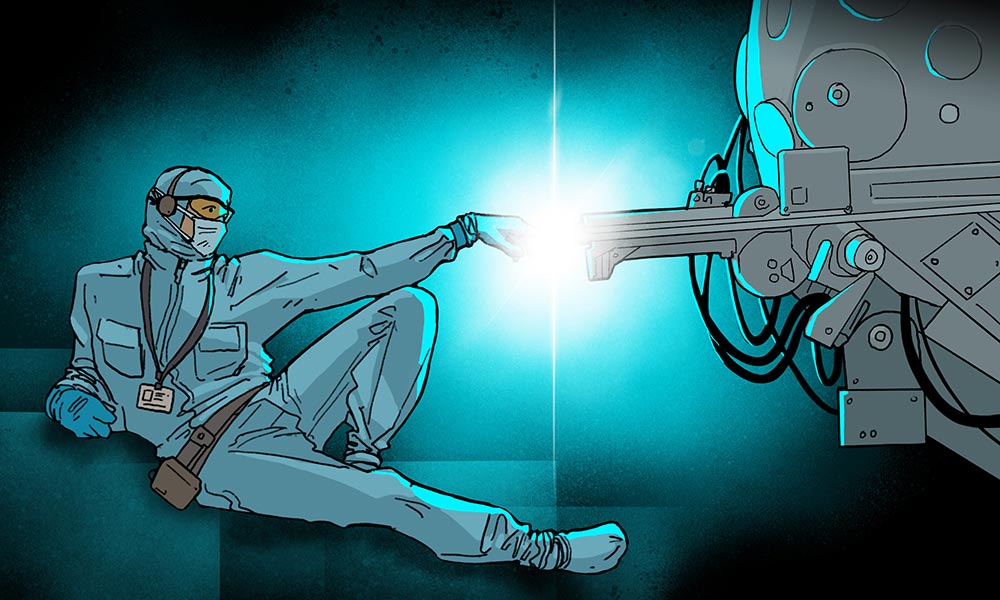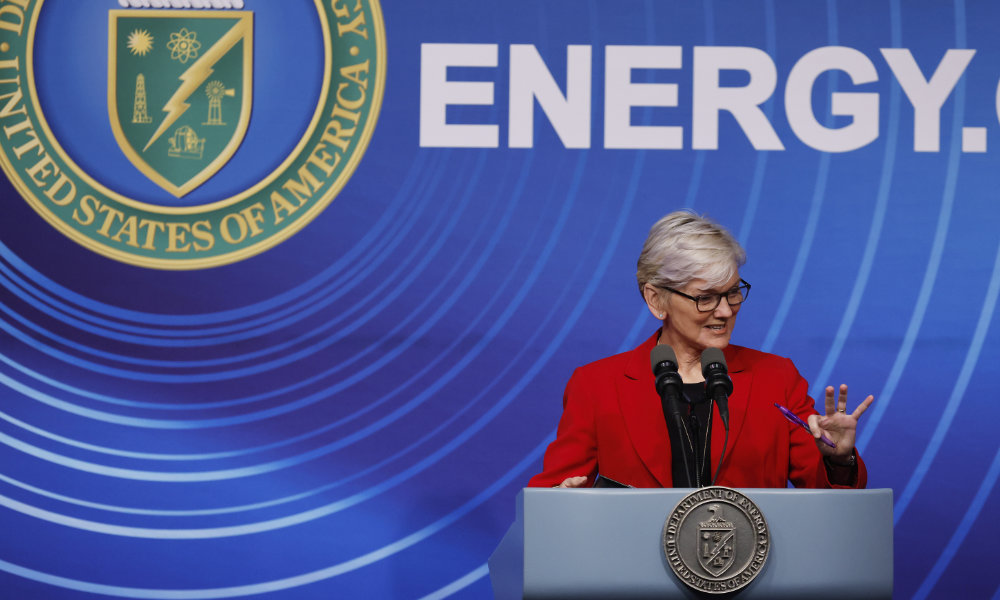The new supercomputer enables a four-fold increase in high-performance computing to simulate high-energy-density physics and inertial confinement fusion experiments.
The University of Rochester’s Laboratory for Laser Energetics (LLE) is one of only several facilities in the world where scientists are studying laser-driven inertial confinement fusion (ICF) for national security purposes and to harvest energy from nuclear fusion. Fusion, which powers the sun, has long been a component of maintaining the nuclear deterrent and is viewed as an ideal potential energy-production mechanism.
In an ICF experiment, a small amount of fuel consisting of hydrogen isotopes, deuterium (D) and tritium (T), is compressed and heated to temperatures greater than the center of stars. When these conditions are achieved, the fuel undergoes fusion, releasing enormous energy. The nature of ICF makes it challenging to study experimentally. But advances in high-performance computing are giving University researchers and LLE scientists a crucial technological edge.
“A new supercomputer housed at the University will make it possible for researchers to simulate complex high-energy-density phenomena in ICF in three dimensions with unprecedented details,” says Valeri Goncharov, Theory Division Director and a distinguished scientist at LLE. “For example, the evolution of micron-size target defects in an implosion is very difficult, if not impossible, to measure directly. Detailed 3D simulations, however, can model how this phenomenon can change the experimental observables that are much easier to measure. Finding correlations between simulation results and experimental data will help in identifying the importance of subscale target features and other complicated physics effects in our experiments.”
In addition to direct-physics modeling, the supercomputer, dubbed “Conesus” after one of the Finger Lakes in the Greater Rochester region, also enables using artificial intelligence and machine-learning tools to advance progress in high-energy-density (HED) science.
As the largest US Department of Energy (DOE) National Nuclear Security Administration (NNSA) university-based research program in the nation, the University and LLE are “the perfect venue for the new system,” says Chris Deeney, director of LLE. “Conesus will provide unique educational and research opportunities for students and faculty in the Rochester region and across the nation.”
“LLE is an extremely productive ICF and high-energy-density physics research facility conducting thousands of experiments for hundreds of scientists each year,” says Stephen Dewhurst, Rochester’s vice president for research. “The advance in computing power Conesus provides will allow LLE and its collaborators to better analyze existing data as well as plan new experimental campaigns more effectively. Our partnership with DOE/NNSA, Dell, Intel, and New York State has been invaluable, and I look forward to the future discoveries this new system will enable.”

High-power supercomputer meets energy efficiency
The Conesus supercomputer has already received several impressive distinctions, earning a place on the most recent TOP500 list of the most powerful computer systems in the world and the GREEN500 list, denoting the world’s most energy-efficient supercomputers.
The machine was manufactured by Intel and developed in partnership with Dell Technologies and Lawrence Livermore National Laboratories (LLNL). It is one of only seven of Intel’s fourth-generation Sapphire Rapids systems in the world on the current TOP500 list and one of two in the United States.
The TOP500 project began in 1993 and publishes an updated list of the world’s most powerful supercomputers twice a year. This is the fifth time a Rochester system has made the list, but Conesus represents a large increase in computer capability since a Rochester system last made the list with the Blue Gene-Q supercomputer in 2012.
Using supercomputers to simulate fusion
The LLE has two very powerful lasers—OMEGA and OMEGA EP—that researchers use to conduct studies, including those involving ICF. The work builds on the momentum of scientists’ breakthrough in achieving ignition, or a fusion reaction that creates a net energy gain, last year at LLNL’s National Ignition Facility (NIF).
“Approximately ten times a day, our lasers are used to make a star in a jar,” says William Scullin, leader of LLE’s high-performance computing group.
But the path to ICF starts with supercomputers to model the materials, the lasers, and the experiments themselves.
“We’ve got 1D-, 2D-, and 3D-modeling capabilities for modeling inertial confinement fusion,” Scullin says. “We do simulations of materials and plasmas at extremes of temperatures and pressures. High-power lasers are not a commercially available component. So, in house we designed a lot of our own optics and laser systems. Additionally, increasingly, there’s a lot of statistical work to be done.”
According to Scullin, with the increase in statistical analysis needed, computational scientists are exploring how they can use machine learning to see what they can discover from both older data and newer data. To make such discoveries possible, LLE needed new computing resources.

Future simulation projects
Scullin says that Conesus will provide scientists computing resources to collect more data and perform higher-resolution studies, including using machine learning on bigger datasets. Projects that might have taken 30 weeks to run on earlier systems can be completed in a matter of a few days using Conesus.
Several projects are already planned for Conesus, including testing statistical modeling of the OMEGA laser systems’ cryogenic implosions; simulating alpha particles stopping and burning plasmas; and studying liquid crystals that produce a large response with a very high degree of thermal stability.
The new system was supported by a strong partnership between multiple groups at the US Department of Energy and the National Nuclear Security Administration as well as state funding from the New York State Energy Research and Development Authority (NYSERDA) and Empire State Development (ESD).
“We could not have made this leap forward without the support of NNSA and their willingness to let us partner with the national laboratories,” says Deeney. “Our New York State funding enables LLE to make strategic investments and the new storage system to exploit the power of the new computer will be another great example.”
Advancing high-performance computing at Rochester
The high-performance computing advances represented by Conesus prompted government officials to add:
US Senator Charles Schumer: “University of Rochester’s Laboratory for Laser Energetics’ new supercomputer cluster ‘Conesus’ is a perfect example of government agencies working side-by-side with cutting-edge researchers to enhance our nation’s security and clean-energy goals. This is a win-win which will support advancements in inertial confinement fusion research, and will also provide workers and students at LLE with one of the top computer systems in the world to give them the technological edge they need to continue conducting their groundbreaking work here in Rochester.”
US Senator Kirsten Gillibrand: “With the University of Rochester hosting one of the most powerful supercomputers in the world, the university demonstrates its preeminent leadership in high-performance computing research. Conesus will help pave the way for strengthening our national security capabilities, and has the potential to achieve long-sought breakthroughs in clean energy development. This is a tremendous asset for the Rochester-Finger Lakes region, New York, and beyond.”
Congressman Joe Morelle: “By expanding their high-performance computing capabilities, the University of Rochester is leading the way in improving our national security, understanding the universe, and training the next generation of scientists. Having systems in the TOP500, they will now have the ability to simulate fusion—for defense missions now and a safe, clean energy alternative in the future. Our region is truly an innovation leader.”
New York State Senator Jeremy Cooney: “The new supercomputer cluster, ‘Conesus,’ is a revolutionary addition to the University of Rochester’s Laboratory for Laser Energetics. This high-performance computing system provides a four-fold increase in simulating high-energy-density physics and inertial fusion experiments. LLE students and workers will be empowered to generate thousands of safe, clean, and cost-effective fusion experiments yearly, further enhancing and expanding computing power and opportunities for the Rochester region.”
New York State Assemblymember Sarah Clark: “The Laboratory for Laser Energetics’ new high-performance computing cluster is a step forward for energy research. This new cluster, and its ranking for both performance and energy efficiency, will help keep Rochester as a destination for research and new business development.”
Hope Knight, President and CEO, ESD: “This powerful, state-of-the-art supercomputer will ensure that the University of Rochester’s Laboratory for Laser Energetics plays a leading role in next-generation discoveries. Governor Hochul’s administration is committed to investing in cutting-edge R&D that strengthens New York as a global innovation powerhouse delivering laser-focused economic growth.”
Doreen Harris, President and CEO, NYSERDA: “NYSERDA is proud to have supported the critical work of the Laboratory for Laser Energetics which, in collaboration with federal partners, has led to this remarkable high-performance computing advancement today. I commend all those who have contributed to this achievement and look forward to the many innovative successes that are sure to come from this world-renowned facility.”
About the University’s Laser Lab
LLE was established at the University in 1970 and is the largest US Department of Energy university-based research program in the nation supported by the National Nuclear Security Administration as an integral part of its Stockpile Stewardship Program. LLE has received support from the New York State Energy Research and Development Authority, and most recently, from Empire State Development.
As a center for the investigation of the interaction of intense radiation with matter, LLE is a unique national resource for research and education in science and technology. Current research includes exploring fusion as a future source of energy, developing new laser and materials technologies, and better understanding high-energy-density phenomena. In addition to its vital roles in various areas of scientific research and its support of the local high-tech economy, LLE plays an important role in educating the next generation of scientists and engineers.
The NNSA-funded National Laser Users’ Facility (NLUF) is hosted at Omega, and scientists and students from across the nation and around the world carry out fundamental research, training, and education. Additional facility access for qualified external researchers is made possible through LLE’s participation in DOE’s LaserNetUS.
Read more
 What is fusion, and why is it so difficult to create?
What is fusion, and why is it so difficult to create?
Fusion is the energy of nature, powering the stars and making it possible for life to exist on Earth. But achieving fusion power has eluded researchers for decades.
 Scientists hit key milestone in fusion energy quest
Scientists hit key milestone in fusion energy quest
The major breakthrough of achieving ignition was cause for celebration at Rochester’s Laboratory for Laser Energetics as well.
 Laboratory for Laser Energetics joins team to develop commercial fusion energy
Laboratory for Laser Energetics joins team to develop commercial fusion energy
The US Department of Energy program partners private companies with national laboratories and universities to design the first commercial fusion power plant.





